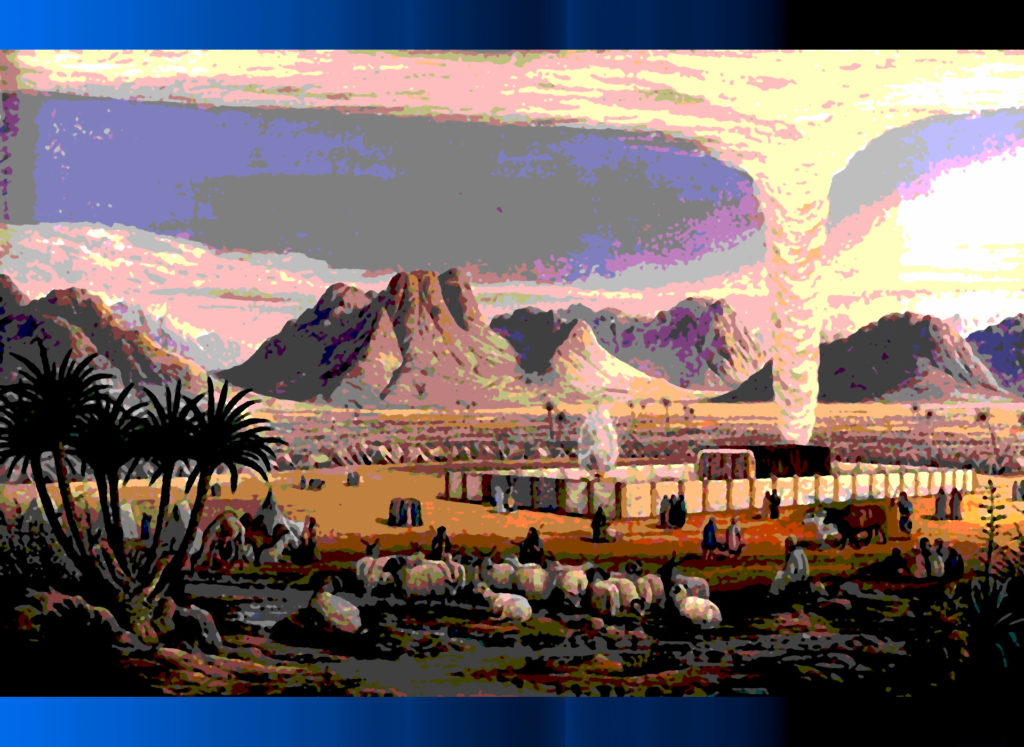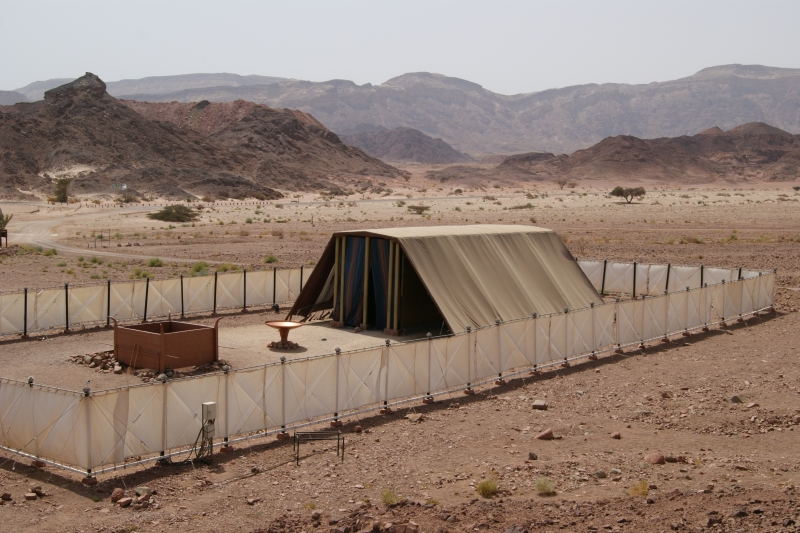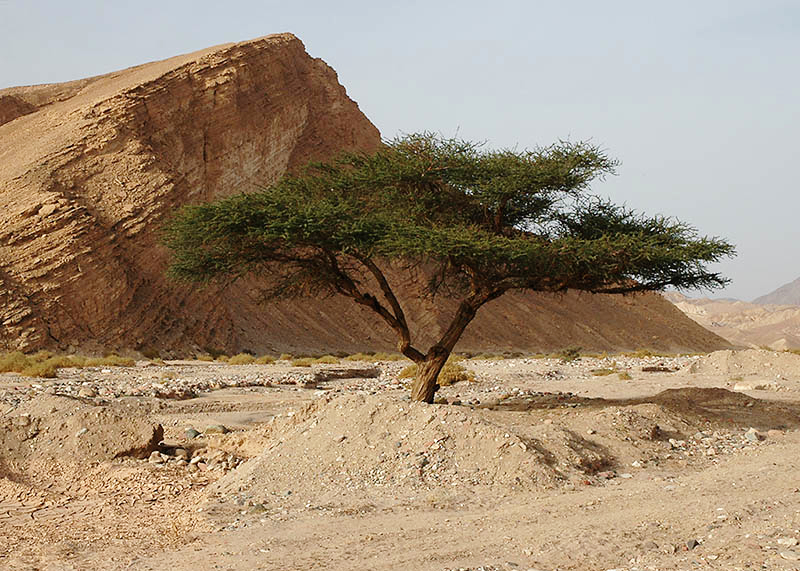
(3-4 Minute Read)
Exodus 25:1 – 27:19
In Terumah, the Almighty spoke to Moses in order to tell the Israelites to provide voluntary donations of gold, silver, copper, colored yarns, fine linen, animal skins, oil, spices, jewels, and more. The Most High would show them the pattern of a sanctuary — the Tabernacle — that they would construct that He may dwell among them.
They would make an ark of acacia wood about 3.75 feet long, 2.25 feet wide, and 2.25 feet high. It would be overlaid with gold and outfitted with rings for wooden carrying poles also covered with gold. Inside the ark, the tablets of the Pact [Covenant] would be stored. They would make a cover of pure gold with cherubim [angelic beings] on top. From between the two cherubim the Holy One, Blessed be He, would meet with Moses and communicate with him concerning the Jewish people.
They would make a table of acacia wood, 3 feet long, 1.5 feet wide, and 2.25 feet high. It would be overlaid with gold, with molding and rings for carrying poles. The bowls, ladles, and jars would be made of gold for libations. They would set the bread of display [“shewbread”] on it perpetually.
They would make a lampstand of pure, hammered gold; all of one piece. It would have six branches (plus the middle branch), making a total of seven lamps. Each lamp would house cups shaped like the calyx [bulb-like flower petal formation] of an almond blossom. The tongs and fire pans would also be made out of pure gold.
The Eternal One emphasized that Moses should note well the pattern shown to him on the mountain, and follow it carefully.
The Tabernacle would be constructed of ten strips of cloth of colored yarns of blue, purple, and crimson, with the design of cherubim worked into them. Each cloth would be 42 feet long and 6 feet wide. Cloth loops and golden clasps would be incorporated into the material to join them together.

Eleven strips of goat hair material would be made for a tent over the Tabernacle, 45 feet long and 6 feet wide. The strips would also utilize cloth loops and copper clasps. The extra strip of material would cover the back of the Tabernacle. The tent itself would have a covering tanned ram skins and tachash* skins.
They would make planks of acacia wood, 15 feet long and 2.25 feet wide, and outfitted with tenons and sockets along with wooden bars of support. Twenty planks would be made for the north and south sides of the Tabernacle each, and eight planks for the rear and corners in the west. (48 in total.) The planks would be overlaid with gold and be outfitted with rings of gold to hold the supporting bars, which were also covered with gold.
Together, these constructed materials would be set up as the Tabernacle according to the manner shown to Moses on the mountain.
A curtain of colored yarns would be made with embroidery of cherubim and hung inside the Tabernacle. The curtain would be hung on wooden bars overlaid with gold and having hooks of gold and sockets of silver. It would separate the Holy place from the Holy of Holies, and the Ark of the Pact (Covenant) and its cover would be placed behind it (in the Holy of Holies). The table (for the bread of display) and the lampstand would be placed before the curtain (in the Holy place) on the north and south walls respectively. A screen would also be made for the entrance of the Tabernacle of colored yarn along with a support of wooden bars overlaid with gold, with golden hooks and sockets of copper.
They would make an square altar of acacia wood, 7.5 feet long and 7.5 feet wide. Horns would be on the corners, and it would all be overlaid with copper. All the utensils thereof, including flesh hooks, fire pans, ash pails, and more, would be made of copper. A mesh grating and rings would also be made of copper, and the rings would hold wooden carrying poles overlaid with copper.
As it was shown on the mountain, so it was to be made.
The enclosure [outer perimeter “wall”] beyond the Tabernacle was to be made of 150 feet of hangings of fine twisted linen on both the north and south sides, as well as 75 feet of material hangings on the west side. On the east (front) side, two sets of twisted linen 22.5 feet long would hang on each side of the “gate.” (420 feet of twisted linen in total.) The “gate” would be a screen 30 feet wide of both colored yarn and twisted linen with its posts and sockets.
All the posts of the enclosure along with their hooks would be banded with silver. Their hooks and sockets would be made of silver and copper respectively.
The dimensions of the enclosure would be 150 feet by 75 feet, and the height of it would be 7.5 feet.

An immediate question arises in regards to the Mishkan, or Tabernacle. The Torah and Tanakh as expounded by such rabbinical giants as Rabbi Moshe Ben Maimon, or the Rambam, emphasize that the Almighty has no body or tangible, corporeal form. The Holy One, Blessed be He, cannot be contained or defined by any boundary or dimension. How, then, could the Most High “dwell” among the Jewish people? And in a structure that could be described as a fancy tent no less! Even King Solomon rhetorically inquired in Melekhim Aleph / I Kings 8:27, “But will G-d in very truth dwell on the earth? Behold, heaven and the heaven of heavens cannot contain You; how much less this house [Temple] that I have built!”
If the Mishkan, or Tabernacle (and later the Beit HaMikdash, or Temple) could not possibly “house” or “contain” the Almighty, what then, was the purpose of these structures?
Famed Sephardi scholar Rabbi Don Yitzchak Abravanel examined this question at length. In a word, the primary focus of his answers was that the Mishkan was actually for us as finite human beings rather than for the Eternal One. As humans, we ultimately cannot possibly reach the level of the Almighty. So, in His mercy and compassion, the Most High comes down to our level. Perhaps the most obvious examining of this yeridah, or coming down, is the Mount Sinai encounter. The Jewish people couldn’t come up to the level of the Almighty. In fact, they couldn’t even climb up the physical mountain during the experience without forfeiting their lives; only Moses could do so. In a sense, the Mishkan was the Most High’s method of perpetuating the yeridah at Mount Sinai into an ongoing spiritual experience. The Jewish people couldn’t spend the rest of their lives standing around Mount Sinai. Instead, they had to create a portable structure that enabled them to bring that encounter with them as they approached the land of Israel. Later, when the land of Israel was established, the Mishkan was replaced by the Beit HaMikdash.

Accordingly, the Mishkan served as a focal point to connect with the Almighty in a physical sense, even though He is not a physical Being. Judaism is based on the concept of elevating ourselves spiritually through physical means. For instance, we eat Kosher food and pray with tefillin — both highly physical activities — as a means to a spiritual end. So, too, the Mishkan and the Levitical service thereof is a physical mechanism for spiritual elevation and connection with the Almighty.
Abravanel elaborates on these concepts further, additionally giving his thoughts that the design and materials of the Mishkan symbolize an important principle. Much of the Mishkan was constructed of expensive materials, such as gold, silver, fine cloth, animal skins, etc. The construction of the Mishkan represents the idea that the physical universe is a “concealment” and “outer garment” of the Most High. Just as the physical components of the Mishkan can enable us to connect with the Almighty, so, too, proper utilization of the physical universe according to the Torah can provide the mechanism to have a relationship with the Most High. However, an excessive desire for or preoccupation with the physical world, especially wealth (like gold, silver, finery, etc.) or occupations (like craftsmanship, tanning, weaving, etc.) can actually separate us from the Almighty. Abravanel asserts that the Mishkan represents that the same physical universe that allows us to connect with the Most High can also separate us from Him. The key factor is how we live in the tangible world and utilize it according to the Torah.
May the Holy One, Blessed be He, grant us to merit that He “comes down” to our level in order to facilitate an ongoing relationship. And may the Holy One, Blessed be He, ever enable us to utilize the physical universe to achieve higher spiritual levels through Torah observance, and shun the materialism that drives us away from Him.


